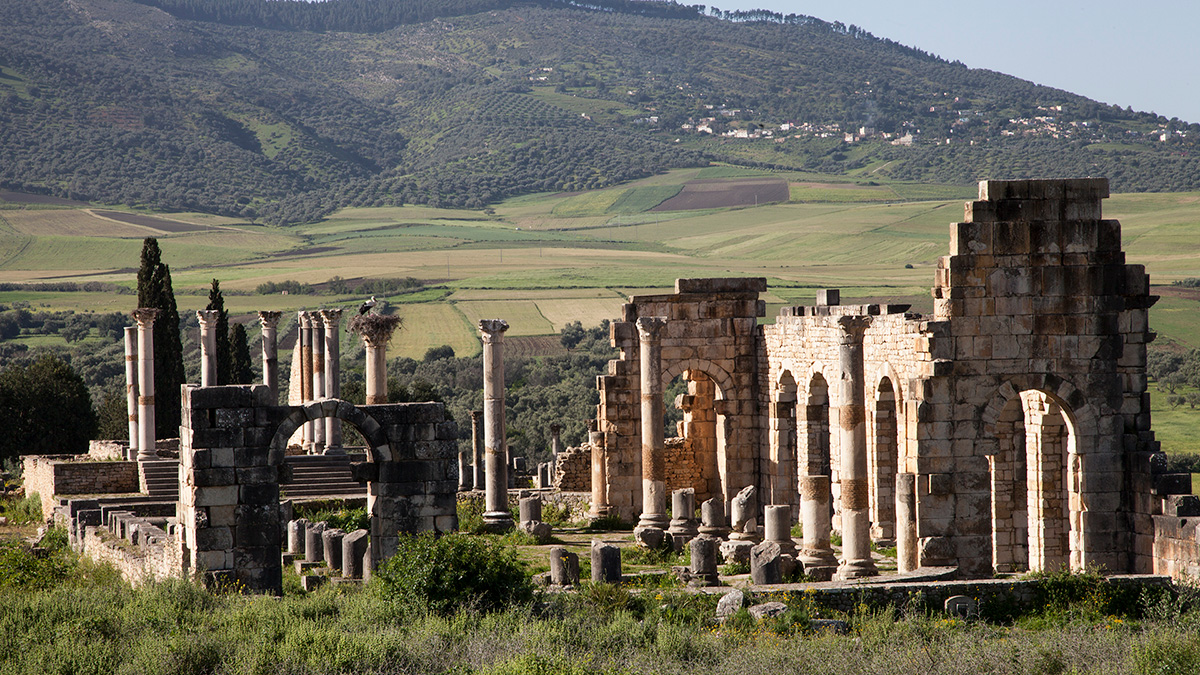Thousands of years ago in the Roman city of Volubilis, mills crushed olives or grain and bakeries mixed dough in stone vats. Volubilis, in modern-day Morocco, still bears evidence of these activities today—in the form of enormous mixers and millstones that sit on the ancient site’s ruins. Now, a study of these stone tools’ geochemistry suggests a local source for the stones—and that ancient people knew which rocks were best suited to each task.
Mixers and millstones would have held significance to the people who lived in Volubilis because of their roles in daily life and the economy, said igneous petrologist Derek Weller. “We can actually use them to understand something about the culture,” said Weller, engaged in the study while at the Earthquake Research Institute at the University of Tokyo. He is now at Yachay Tech University in Ecuador.
Weller and his colleagues examined the mineral makeup of samples from 16 millstones and mixing vats from the Roman era, between the 1st and 8th centuries CE, including some collected from areas that once were bakeries, mills, and homes. Some tools were made of limestone, and others were basalt.
Locally Quarried Basalts
The team focused on the basalt. Basalt is an igneous rock, and the tectonic environment in which magma forms influences basalt’s chemical composition, including trace elements that can link a rock to its region of origin. For example, Weller said, volcanic rocks from sites in Sardinia and Sicily have well-known geochemical signatures. Researchers have been able to reconstruct trade routes by sourcing millstones and mixers made from those Mediterranean rocks. But there’s been comparatively little work on tools from Volubilis.
The researchers compared ratios of trace elements—such as titanium, niobium, and vanadium—in the Volubilis basalt tools with those of volcanic rocks from places in Europe and the Mediterranean. This ruled out many potential sources but left locales in France, Sicily, and Spain, along with the Middle Atlas mountain range in Morocco. The team then applied an algorithm that compared samples’ compositions with ones reported in the literature for those sites. Each Volubilis basalt had a high probability of originating in the Middle Atlas, the researchers reported in the August issue of the Journal of Archaeological Science: Reports.
“They must have had a good system of infrastructure to sustain the commercialization of these materials.”
“The power of this paper is to give a lot of chemical analysis” confirming that the basalts came from the Middle Atlas, said Abdelilah Dekayir, a geologist at Moulay Ismail University in Meknès, Morocco, who was not involved with the new research. Because of the essentially identical compositions of the Volubilis basalt tools, their stone likely came from a single quarry, Weller noted.
Weller and his team were unable to confirm an origin for the limestone tools. Limestones don’t carry a geochemical fingerprint as basalts do, Weller said. Previous researchers reported several quarries in the area near Volubilis, which may be the source of these stones, the researchers wrote. But such limestone can be found across northern Africa, and this study doesn’t confirm a source near Volubilis, Dekayir said. Isotopic analysis would be more helpful in sourcing these stones and determining whether there were few quarries or many, he added.
Though the Middle Atlas quarries are closer than European sources, it still would have been difficult work bringing the basalts to Volubilis. Many of the millstones were large objects—a meter tall and 40–50 centimeters wide, Weller said.
“They must have had a good system of infrastructure to sustain the commercialization of these materials,” said Elisabetta Gliozzo, an archaeological scientist at the University of Bari Aldo Moro in Italy who was not part of this study. Ancient people would have used rivers and streets to transport stone, she explained.

Fitting Form to Function
For each of the three tool types—millstones for making olive oil, millstones for making flour, and mixers for dough—researchers found that only one stone type was used, suggesting that artisans matched the qualities of each stone to its function. “This tells us that they were very smart,” said Gliozzo.
For instance, the impermeability of fossil-poor limestone makes it ideal for blending wet ingredients in a dough, whereas the rough but porous surface of basalt worked well for grinding grain. These people chose exactly what stones they needed to make the right tools for processing a variety of materials, Gliozzo said.
—Carolyn Wilke (@CarolynMWilke), Science Writer
This news article is included in our ENGAGE resource for educators seeking science news for their classroom lessons. Browse all ENGAGE articles, and share with your fellow educators how you integrated the article into an activity in the comments section below.


